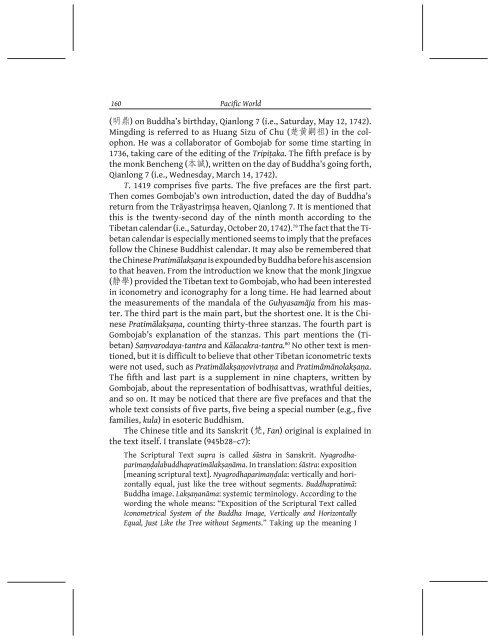download - The Institute of Buddhist Studies
download - The Institute of Buddhist Studies
download - The Institute of Buddhist Studies
Create successful ePaper yourself
Turn your PDF publications into a flip-book with our unique Google optimized e-Paper software.
160<br />
Pacific World<br />
( 明 鼎 ) on Buddha’s birthday, Qianlong 7 (i.e., Saturday, May 12, 1742).<br />
Mingding is referred to as Huang Sizu <strong>of</strong> Chu ( 楚 黄 嗣 祖 ) in the colophon.<br />
He was a collaborator <strong>of</strong> Gombojab for some time starting in<br />
1736, taking care <strong>of</strong> the editing <strong>of</strong> the Tripiṭaka. <strong>The</strong> fifth preface is by<br />
the monk Bencheng ( 本 誠 ), written on the day <strong>of</strong> Buddha’s going forth,<br />
Qianlong 7 (i.e., Wednesday, March 14, 1742).<br />
T. 1419 comprises five parts. <strong>The</strong> five prefaces are the first part.<br />
<strong>The</strong>n comes Gombojab’s own introduction, dated the day <strong>of</strong> Buddha’s<br />
return from the Trāyastriṃṣa heaven, Qianlong 7. It is mentioned that<br />
this is the twenty-second day <strong>of</strong> the ninth month according to the<br />
Tibetan calendar (i.e., Saturday, October 20, 1742). 79 <strong>The</strong> fact that the Tibetan<br />
calendar is especially mentioned seems to imply that the prefaces<br />
follow the Chinese <strong>Buddhist</strong> calendar. It may also be remembered that<br />
the Chinese Pratimālakṣaṇa is expounded by Buddha before his ascension<br />
to that heaven. From the introduction we know that the monk Jingxue<br />
( 静 學 ) provided the Tibetan text to Gombojab, who had been interested<br />
in iconometry and iconography for a long time. He had learned about<br />
the measurements <strong>of</strong> the mandala <strong>of</strong> the Guhyasamāja from his master.<br />
<strong>The</strong> third part is the main part, but the shortest one. It is the Chinese<br />
Pratimālakṣaṇa, counting thirty-three stanzas. <strong>The</strong> fourth part is<br />
Gombojab’s explanation <strong>of</strong> the stanzas. This part mentions the (Tibetan)<br />
Saṃvarodaya-tantra and Kālacakra-tantra. 80 No other text is mentioned,<br />
but it is difficult to believe that other Tibetan iconometric texts<br />
were not used, such as Pratimālakṣaṇovivtraṇa and Pratimāmānolakṣaṇa.<br />
<strong>The</strong> fifth and last part is a supplement in nine chapters, written by<br />
Gombojab, about the representation <strong>of</strong> bodhisattvas, wrathful deities,<br />
and so on. It may be noticed that there are five prefaces and that the<br />
whole text consists <strong>of</strong> five parts, five being a special number (e.g., five<br />
families, kula) in esoteric Buddhism.<br />
<strong>The</strong> Chinese title and its Sanskrit ( 梵 , Fan) original is explained in<br />
the text itself. I translate (945b28–c7):<br />
<strong>The</strong> Scriptural Text supra is called śāstra in Sanskrit. Nyagrodhaparimaṇḍalabuddhapratimālakṣaṇāma.<br />
In translation: śāstra: exposition<br />
[meaning scriptural text]. Nyagrodhaparimaṇḍala: vertically and horizontally<br />
equal, just like the tree without segments. Buddhapratimā:<br />
Buddha image. Lakṣaṇanāma: systemic terminology. According to the<br />
wording the whole means: “Exposition <strong>of</strong> the Scriptural Text called<br />
Iconometrical System <strong>of</strong> the Buddha Image, Vertically and Horizontally<br />
Equal, Just Like the Tree without Segments.” Taking up the meaning I
















